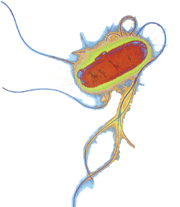
- Select a language for the TTS:
- UK English Female
- UK English Male
- US English Female
- US English Male
- Australian Female
- Australian Male
- Language selected: (auto detect) - EN
Play all audios:
Access through your institution Buy or subscribe BEATING DIFFRACTION IN THE FAR FIELD Diffraction makes it impossible to resolve those features of an object that are smaller than the
wavelength of the light used to probe it. Yet this most basic principle of optics — known as the diffraction limit — has its exceptions. Perhaps the most well-known is that it applies only
to images produced in the 'far field', some distance away from the object. Consequently, it is possible to resolve subwavelength features in an object by scanning a probe (such as
the end of an optical fibre) through the optical field in the immediate vicinity of an object bathed in light — which is how a near-field scanning optical microscope works. This is a preview
of subscription content, access via your institution ACCESS OPTIONS Access through your institution Subscribe to this journal Receive 12 print issues and online access $259.00 per year only
$21.58 per issue Learn more Buy this article * Purchase on SpringerLink * Instant access to full article PDF Buy now Prices may be subject to local taxes which are calculated during
checkout ADDITIONAL ACCESS OPTIONS: * Log in * Learn about institutional subscriptions * Read our FAQs * Contact customer support RIGHTS AND PERMISSIONS Reprints and permissions ABOUT THIS
ARTICLE CITE THIS ARTICLE Swimming, diffracting, condensing. _Nature Phys_ 2, 651 (2006). https://doi.org/10.1038/nphys435 Download citation * Issue Date: October 2006 * DOI:
https://doi.org/10.1038/nphys435 SHARE THIS ARTICLE Anyone you share the following link with will be able to read this content: Get shareable link Sorry, a shareable link is not currently
available for this article. Copy to clipboard Provided by the Springer Nature SharedIt content-sharing initiative







